|
WHAT
IS A CIBACHROME PRINT?
The
Cibachrome process of printing from slides and transparencies was developed by the Ciba-Geigy Corporation
of Switzerland and introduced in 1963. Since then the name was changed to
Ilfochrome Classic when Ilford purchased the Cibachrome manufacturing
facility and was then, in turn, purchased by International Paper. Both names
are still being used.
Cibachrome prints have been used in museums
for displaying images and everywhere else that high quality archival
prints are needed. They are considered one of the most stable
fade-resistant and affordable color prints available. In fact, they are
made on the most fade resistant material currently available. Unlike
normal color prints that have the pigment on the surface of the paper, the
color pigment in these prints are built into the paper. The dyes are
called AZO dyes and they are known for their exceptional stability and
color purity.
The surface of the prints have a diamond like sparkle
unlike any other print on the market today and the colors are brilliant! The photographs on this page are four of my personal
favorites. Each one represents a different cultural tradition in North
America. The mounted prints are double laminated and could be hung on the wall as-is
without any further framing.
Peter
A. Bostrom 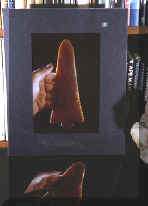
11X14 INCH PRINTS
ARE AVAILABLE AS:
SALON MOUNTED ON 16X20 INCH GATORFOAM & DOUBLE LAMINATED
"OR"
11X14 INCH CIBACHROME PRINT ONLY
(CLICK
HERE FOR ORDERING PAGE & PRICES)
|
|
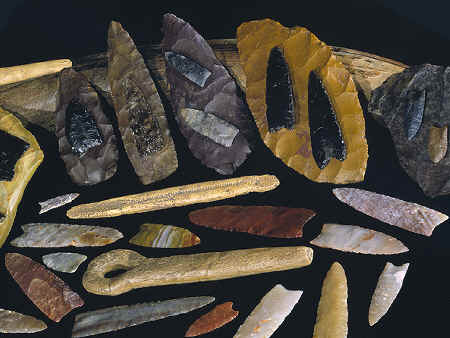
CLICK ON PICTURE FOR LARGE IMAGE
OF ARTIFACTS
IMPORTANT CLOVIS
ARTIFACTS
CLOVIS CULTURE
APPROX.
14,000 YEARS AGO
WESTERN UNITED STATES
This picture was taken on 8x10 film with a large format camera. It shows
some of the most important Clovis artifacts ever discovered.
Artifacts from five different mammoth kill sites are represented. These
are Blackwater Draw, Colby, Domebo, Lange/Ferguson and Murray Springs. The
Clovis culture is the oldest recognized cultural tradition in North
America.
The artifacts in this picture were borrowed from some of the
largest and most important collections in the country. The Drake cache is
in the Smithsonian Institution's collection, the Anzick cache from the Montana
Historical Society, the Colby mammoth kill site points from the University of
Wyoming, the Domebo mammoth kill site points from the Plains Museum, etc. |
|
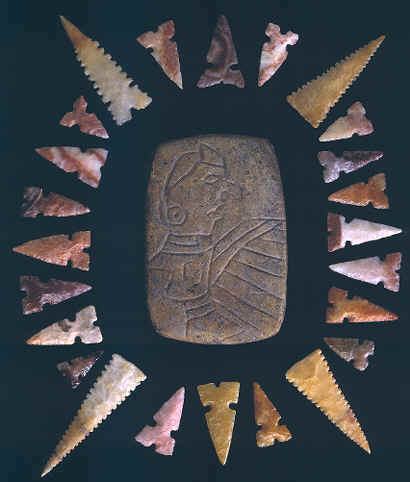
CLICK ON PICTURE FOR LARGE IMAGE
OF ARTIFACTS
BIRDMAN TABLET &
CAHOKIA POINTS
MISSISSIPPIAN CULTURE
1,200 TO 500
YEARS AGO
CAHOKIA MOUNDS STATE HISTORIC SITE
Many of the Mississippian sites such as Moundville, Etowah or Spiro have
singular artifacts that become almost a logo for that particular site. The
focal point of this picture is the Birdman Tablet which is the Cahokia
Mound site's most famous artifact and the single most recognizable image for
this site. The "Birdman" image has even been placed on nearby bridges on the interstate highway system. The
Birdman Tablet was found during excavation on the east ramp of the 103
foot high Monks Mound at Cahokia.
The arrow points surrounding the tablet are Cahokia points. The four largest points
were excavated
several years ago from mound 72 where approximately 1200 other points were discovered. The other 20
Cahokia points were surface collected in plowed fields around the mounds.
|
|
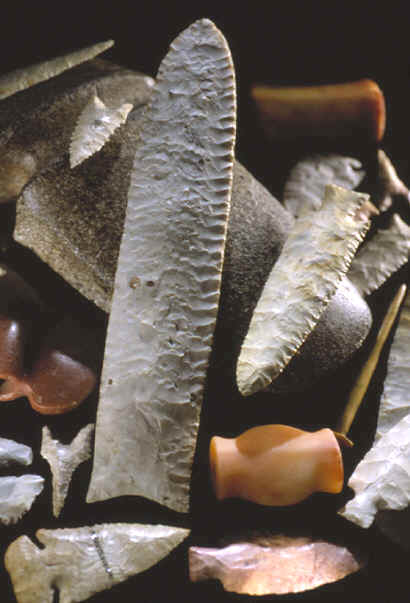
CLICK ON PICTURE FOR LARGE IMAGE
OF ARTIFACTS
ARCHAIC ARTIFACTS
ARCHAIC PERIOD
10,500 TO
3,000 YEARS AGO
MISSOURI & ILLINOIS
FLOYD RITTER
COLLECTION
This picture centers around a large Sloan Dalton point. The lighting
highlights the very uniform pressure
flaking along the edge. Dalton
points that exceed 10 inches in length are very rare. This example
measures 10 1/4 inches long and represents only a handful that have been
recorded of this size. This Dalton
point is so skillfully flaked that there is currently no one that could make one just
like it. This type of flaking is called "hollow ground" flaking
which is a manufacturing technique unique to the Dalton Culture in the
United States. The edge is very thin but the center is thick and
"rounded". The flakes travel in to the thick center
where they smoothly curled up and around with no step fracturing.
All the artifacts in this picture belong to the Archaic
cultural tradition. This period was the longest lasting cultural tradition
in the eastern United States. These people hunted with spears thrown with
throwing sticks called atlatls. The three orange and red quartz objects in
this picture are Bannerstones that were once attached to throwing sticks. This picture shows several good examples of
artifacts that date from the Early Archaic to the Late Archaic
period. |
|
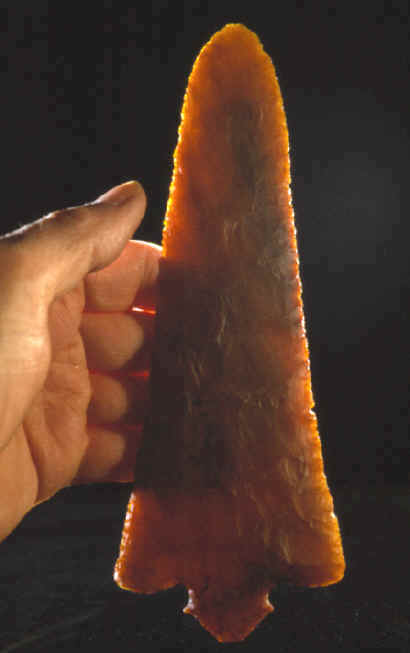
CLICK ON PICTURE FOR LARGE IMAGE
ROSS POINT
WOODLAND PERIOD (HOPEWELL CULTURE)
2,000 TO
1,600 YEARS AGO
ORANGE TRANSLUCENT KAOLIN CHERT
SOUTHERN ILLINOIS
BOB ONKEN
COLLECTION
This is a magnificent example of a Ross point. It measures 8 1/8
inches long and is made of semi-translucent orange Kaolin chert from
southern Illinois. It's the "classic" style with a diamond base.
This one has two stylish points that stick out on each side of the base
that adds to the overall artistic look. It is thin and very skillfully
flaked.
Ross points were made during the Middle Woodland Period as
non utilitarian ceremonial objects. They were named by James B. Griffin
for examples found in Hopewell mounds in Ross County, Ohio. These types of
blades were ceremonially used by the Middle Woodland Hopewell people who
placed them in burial mounds along with other skillfully crafted
artifacts. There are several different styles but the diamond base variety
is the "classic". They seem to have been made as skillfully and
artistically as the craftsman could make them. Not only were they the
largest flaked stone artifacts that the Hopewell people produced they were
also made of the most exotic raw materials. Although the culture that made
them lived east of the Mississippi River some of these points were made of
obsidian from the Yellowstone Park area thousands of miles away. The
Hopewell culture developed extensive trade routes that brought in raw
materials from across the country. |
|
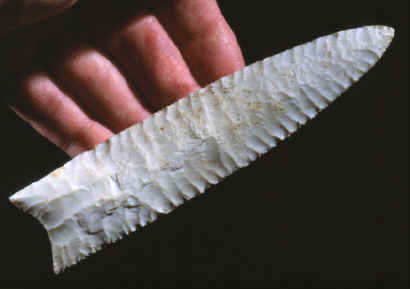
CLICK ON PICTURE FOR LARGE IMAGE
DALTON POINT
OLIVE BRANCH
SITE
ALEXANDER COUNTY, ILLINOIS
EARLY ARCHAIC
PERIOD
9,000 TO 10,500 YEARS AGO
MAURY MEADOWS
COLLECTION
AVAILABLE IN 8X10 CIBACHROME
PRINT ONLY
This Dalton point was found several years ago on the Olive Branch site in
southern Illinois. It was found in a cache of 13 similar Dalton points but
this one is probably the best example. It has very uniform pressure
flaking on both sides. The Early Archaic period in North America produced
some of the best examples of pressure flaked spear and knife points ever
found. All 13 Dalton points in this cache were made of white Burlington
chert.
|





